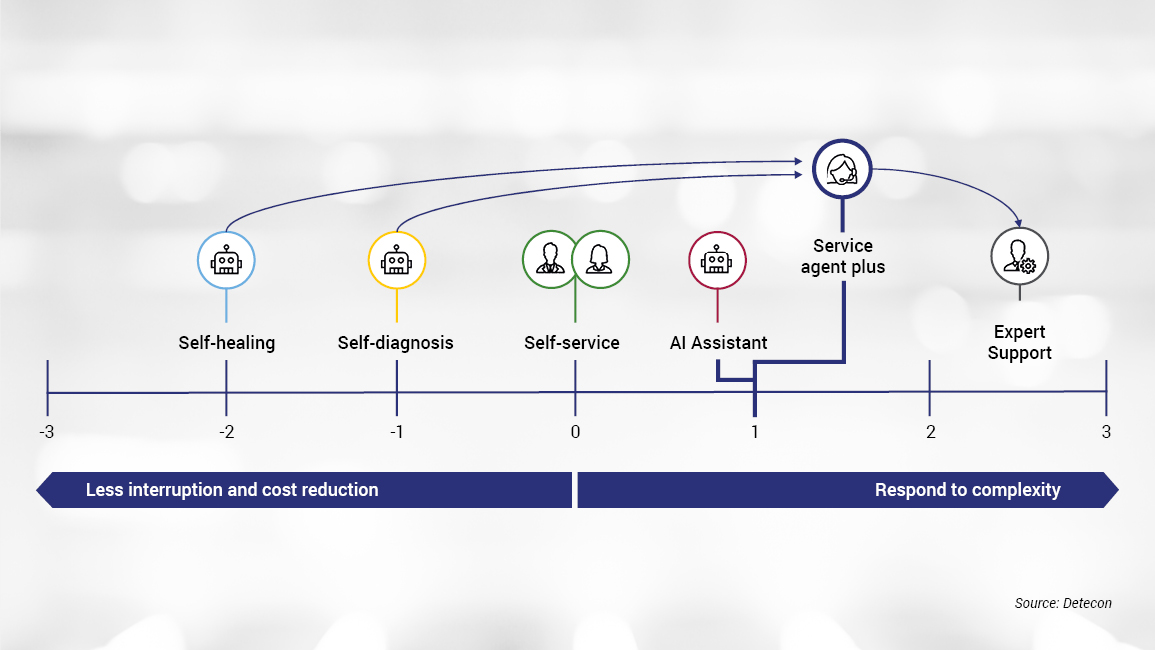Forgotten my password – again! At least one-third of ticket volume is related to the resetting of passwords by the IT service staff. By using a digital solution, you can not only save time and money, but you will also make customers happier. A forgotten password and the resulting barrier to access is a highly annoying and frustrating incident from the user’s perspective. Anne-Kathrin Förster and Andreas Penkert show together with Benjamin Wagner, T-Systems Multimedia Solutions GmbH, how digitalization improves the efficiency of IT services and enhances the customer experience.
The self-image of IT service management in companies has changed rapidly in recent years from that of a specialist department to the image of a service provider as the understanding of the importance of customer centricity in the relationship to internal as well as to external customers has grown rapidly.
Claim
Many CIOs and their IT departments are committed to the importance of providing functioning workstations to their employees so that the latter can perform their work assignments effectively. IT service management supports in this sense the heartbeat of the company and plays an active, formative role in the creation of employee satisfaction.
Sadly, targets for cutting costs in the business management of IT departments often block their ability to satisfy expectations of a professional and fast IT service. Yet this would be immensely important for the ways customers experience the IT service. Employees are customers themselves and have the same high demands on internal service providers as they do on service and products “on the outside.”
The increased demand for cost efficiency intersects a trend in the service desk area that favors the realization of cost-cutting targets: the service desk agent’s purview is changing as staff members are transformed into experts for special service requests. The detection and correction of malfunctions and the processing of service requests could be more comprehensively automated and handled by intelligent systems such as chat bots. Improved self-service features also support and encourage users to go through the solution process independently and autonomously. Moreover, users enjoy a feeling of greater self-reliance, independence, and, ultimately, a personal sense of achievement when they have successfully resolved a malfunction on their own. So high-performance digital self-service solutions generally contribute to a noticeable increase in the user and customer experience.

The trend towards more efficient use of service desk staff follows a shift-left pattern practiced by applying measures that pursue the following objectives:
- Improvement of IT support ticket handling through automation and proactive service optimization based on data analysis and artificial intelligence
- Improvement of the IT self-service, the associated user experience, and independent or automated ticket processing
Efficiency Potential
What service requests and malfunctions can digitalization handle with particular efficiency?
This question must be answered in each specific customer situation. Nevertheless, some service requests and malfunctions lend themselves more easily to rapid automation or digitalization with little effort.
Taking a look at standard solutions, so-called “commercial off the shelf” (COTS) software products, that utilize artificial intelligence to simplify automation can be rewarding.
An “identity and access management as a service” solution can serve as an example.
A common problem for IT users is that they forget their passwords. Most of the time, an SSO feature (using, for example, an active directory (AD) as the main source) for the management of user accounts and related data has been implemented in companies. Changing this master password is subject to strict security requirements that must be satisfied regardless of whether the AD is managed in an on-premise solution or in a cloud environment. However, it is precisely this centralization that leads to a high risk of failure and the concomitant annoyance and dissatisfaction of users whenever they forget this master password.
About a third, in some cases even half, of the ticket volume processed by an IT service desk is generated by password reset requests. We offer in collaboration with COTS software vendors a self-service solution that uses an AD connector and the security standard of 2-factor authentication (authorized mobile phone number and security code). Once it has been implemented, a one-time registration allows users to reset if necessary the Windows start password independently after authentication.
Effect
We recommend the creation of an individual business case appropriate to the exact circumstances of our clients. The following use case illustrates the value contribution.
Of the 30,000 tickets per month, 10,000 concern the resetting of a password.
When the ticket service has been outsourced and billing is based on a price per ticket, an average ticket price for a standard service request is €10 – a cost factor of €100,000.
When defining the savings potential, it should be kept in mind that not all of these requests will go straight to self-service because user behavior and the related acceptance of self-service vary. The goal of providing self-service that is user-friendly should be a major priority so that an adoption rate of at least 80 percent is achieved. Of course, license fees are charged for software use, but such fees are relatively low and still lead to savings of more than 50 percent per ticket. In our example, the company would save €40,000.
The password reset self-service effectively promotes savings in OPEX in the following ways:
- Reducing ticket volume,
- Increasing productivity of the service desk employees by reducing the “mean time to resolve” (MTTR),
- Heightening security through the use of 2-factor authentication,
- Increasing users’ productivity because waiting times at the service desk are eliminated,
while simultaneously creating an opportunity to increase customer satisfaction.
Conclusion
The solution described here has tremendous potential for the digitalization of IT service management. Besides hitting the cost-cutting targets, it generates at the same time a fantastic customer experience and higher employee satisfaction.
We recommend the following procedure to fulfill aspirations for a holistically innovative design of IT service management:
- Gather and analyze ideas and requests for service improvement from the customer’s perspective by creating a customer journey
- Assess their feasibility in terms of specific technological possibilities and capacities while viewing the entire ecosystem strictly from the customer perspective or along the length of the service supply chain
- Define monetary savings targets
- Prepare a capability innovation road map
- Support the development and implementation of measures








